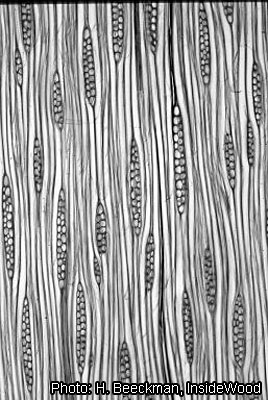Dacryodes normandii (PROTA)
Introduction |
| General importance | |
| Geographic coverage Africa | |
| Geographic coverage World | |
| Fruit | |
| Timber | |
| Fibre | |
| Food security | |
| Conservation status | |
Dacryodes normandii Aubrév. & Pellegr.
- Protologue: Fl. Gabon 3: 72 (1962).
- Family: Burseraceae
Origin and geographic distribution
Dacryodes normandii is probably restricted to Gabon.
Uses
The wood (‘ossabel’) is suitable for light construction, flooring, interior trim, joinery, ship and boat building, vehicle bodies, furniture, cabinet work, toys, novelties, turnery, poles, piles, veneer and plywood. It can also be used for paper making. The cooked fruit is eaten.
Production and international trade
The wood is very similar to ‘ozigo’ (wood of Dacryodes buettneri (Engl.) H.J.Lam) and ‘igaganga’ (wood of Dacryodes igaganga Aubrév. & Pellegr.); it is often sold together with the latter.
Properties
The heartwood is pink-buff with an occasional grey tinge; it is not distinctly demarcated from the sapwood. The grain is often interlocked; texture medium to coarse. The wood is medium-weight, with a density of 550–660 kg/m³ at 12% moisture content. Seasoning should be done carefully, to avoid splitting and twisting. The rates of shrinkage from green to oven dry are 3.8–5.8% radial and 7.1–9.8% tangential. Once dry, the wood is stable in service. The wood is soft. At 12% moisture content, the modulus of rupture is 106–141 N/mm², modulus of elasticity 8700–15,500 N/mm², compression parallel to grain 42–62 N/mm², cleavage 11–22 N/mm and Chalais-Meudon side hardness 2.2–3.6. The wood is moderately easy to saw when green. It works well with hand and machine tools, but causes some blunting due to the presence of silica. It has good nailing and screwing properties, and it glues, sands, paints and varnishes well. Peeling characteristics are satisfactory. The wood is susceptible to termite and marine borer attacks.
Description
- Dioecious, medium-sized to fairly large tree up to 37 m tall; bole straight, cylindrical, up to 100 cm in diameter, with low buttresses; outer bark yellowish, flaking, inner bark pinkish, when cut exuding a fragrant resin becoming amber-coloured on hardening; young branches with caducous rusty stellate hairs.
- Leaves alternate, in tufts at the ends of branches, imparipinnately compound with (6–)8(–9) pairs of leaflets; stipules absent; rachis c. 40 cm long, rusty hairy; leaflets opposite, almost sessile, oblong, c. 16 cm × 5 cm, base asymmetric, apex acuminate, upper surface glabrous, shiny, lower surface densely covered with caducous rusty stellate hairs, pinnately veined with 8–15 pairs of lateral veins. Inflorescence a terminal panicle, rusty hairy.
- Flowers unisexual, regular, rusty hairy; sepals 3, c. 3 mm long, hairy outside; petals 3, c. 5.5 mm long, hairy outside, covered with glandular hairs inside; stamens 6; ovary hairy.
- Fruit an obovoid drupe c. 3.5 cm long, stone with rough surface, 1-seeded.
Other botanical information
Dacryodes comprises about 40 species, occurring in the American, Asian and African tropics. In Africa, about 20 species have been found, all of section Pachylobus. Gabon seems richest with approximately 10 species.
Ecology
Dacryodes normandii occurs in rainforest.
Genetic resources
In view of its very limited distribution, there may be danger of genetic erosion, but so far Dacryodes normandii has not been included in the IUCN Red list.
Prospects
The wood of Dacryodes normandii is suitable for a wide range of applications, but the extent of its current use is unclear. Because of its limited distribution, exploitation of this species should be done with care and in a sustainable way.
Major references
- Aubréville, A., 1962. Burséracées. Flore du Gabon. Volume 3. Muséum National d’Histoire Naturelle, Paris, France. pp. 53–95.
- Bolza, E. & Keating, W.G., 1972. African timbers: the properties, uses and characteristics of 700 species. Division of Building Research, CSIRO, Melbourne, Australia. 710 pp.
- de Saint-Aubin, G., 1963. La forêt du Gabon. Publication No 21 du Centre Technique Forestier Tropical, Nogent-sur-Marne, France. 208 pp.
- Sallenave, P., 1971. Propriétés physiques et mecaniques des bois tropicaux. Deuxième supplément. Centre Technique Forestier Tropical, Nogent-sur-Marne, France. 128 pp.
Other references
- Daly, D.C. & Martínez-Habibe, M.C., 2002. Notes on Dacryodes Vahl, including a new species from the Rio Negro basin in Amazonia. Studies in neotropical Burseraceae. XI. Brittonia 54(4): 266–274.
- Normand, D. & Mariaux, A., 1962. Peut-on distinguer les bois d’ozigo, des safoukala, igaganga et autres Dacryodes? Bois et Forêts des Tropiques 85: 33–40.
- Sallenave, P., 1964. Propriétés physiques et mécaniques des bois tropicaux. Premier supplément. Centre Technique Forestier Tropical, Nogent-sur-Marne, France. 79 pp.
- Takahashi, A., 1978. Compilation of data on the mechanical properties of foreign woods (part 3) Africa. Shimane University, Matsue, Japan, 248 pp.
Author(s)
- M. Brink, PROTA Network Office Europe, Wageningen University, P.O. Box 341, 6700 AH Wageningen, Netherlands
Correct citation of this article
Brink, M., 2008. Dacryodes normandii Aubrév. & Pellegr. In: Louppe, D., Oteng-Amoako, A.A. & Brink, M. (Editors). PROTA (Plant Resources of Tropical Africa / Ressources végétales de l’Afrique tropicale), Wageningen, Netherlands. Accessed 1 June 2025.
- See the Prota4U database.


